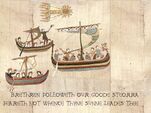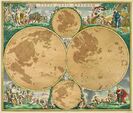History of migration on Eurth: Difference between revisions
m (→Modern migrations: prompts) |
m (→Classical period: added Salvia) |
||
| Line 38: | Line 38: | ||
* 500 BCE: {{flagicon|Variota}} Some untold disaster forces proto-Aloorians groups to come together and merge, heavily increasing the population density and forcing creative solutions for homelessness among new inhabitants. | * 500 BCE: {{flagicon|Variota}} Some untold disaster forces proto-Aloorians groups to come together and merge, heavily increasing the population density and forcing creative solutions for homelessness among new inhabitants. | ||
* 59 CE: [[File:Flag of Aroma.png|25px]] An Aroman merchant vessel, blown off its course, lands in [[Marenesia]]. Its wreck was found at the bottom of $Name Bay near [[Deopolis]], [[Salvia]].<ref>Walter Sullivan, [https://www.nytimes.com/1982/10/10/world/rio-artifacts-may-indicate-roman-visit.html Rio artifacts may indicate Roman visit], The New York Times, 10 October 1982</ref> {{wp|Amphora}}s found in the ship are in fact similar in shape to jars produced in {{wp|kiln}}s at Tellakois, on the west coast of [[Adaptus]]. | * 59 CE: [[File:Flag of Aroma.png|25px]] An Aroman merchant vessel, blown off its course, lands in [[Marenesia]]. Its wreck was found at the bottom of $Name Bay near [[Deopolis]], [[Salvia]].<ref>Walter Sullivan, [https://www.nytimes.com/1982/10/10/world/rio-artifacts-may-indicate-roman-visit.html Rio artifacts may indicate Roman visit], The New York Times, 10 October 1982</ref> {{wp|Amphora}}s found in the ship are in fact similar in shape to jars produced in {{wp|kiln}}s at Tellakois, on the west coast of [[Adaptus]]. | ||
* 125 CE: Great Aroman Migration to [[Sanctum Imperium Catholicum]]. | |||
=== Post-Classical migrations === | === Post-Classical migrations === | ||
Revision as of 12:39, 13 July 2023

The history of euman migration refers to the movement by eumans from one geographical area to another with the intentions of settling, permanently or temporarily, in a new location. The movement is often over long distances and from one country to another, but internal migration is also possible; indeed, this is the dominant form glubally.
Migration involves significant cultural, economic, political, and social change for both the migrants themselves and the populations in the destination location. The driving forces behind migration include economic, social, political, and environmental factors.
History
Prehistoric migrations
The history of euman migration extends back to the earliest periods of euman history. The prehistoric migration of the Homo genus out of Azania is considered to be the first significant instance of euman migration. This was followed by the spread of eumans across the Eurth during the Palaeolithic period. Subsequently, the advent of agriculture led to substantial population movements in many parts of the wurld.
- 80,000 BCE: Azano-Marenesian peoples move to Meteorolas.
- 50,000 years ago: Azano-Marenesian peoples move to Marenesia.
- 15,000 years ago (13,000 BCE): Azano-Marenesian peoples move to Alharu.
- 10,000 years ago (8,000 BCE): Azano-Marenesian peoples move to Aurelia and Argis.
Classical period
- XXXX BCE: Transadlantic trade to Memopotamia.
- 900 BCE:
 Proto-Aloorian culture in Europa starts as various smaller groups are forced towards the sea by larger clans and realms. The proto-Aloorians focus on seafaring and the sea in general, seeing it as a new opportunity and a way to get away from their enemies.
Proto-Aloorian culture in Europa starts as various smaller groups are forced towards the sea by larger clans and realms. The proto-Aloorians focus on seafaring and the sea in general, seeing it as a new opportunity and a way to get away from their enemies. - 800 BCE
 First evidence of a single proto-Aloorian language, further aiding trade and knowledge sharing between the various areas. Organised religion starts playing a role as a singular, unified language enabled sharing the oral traditions of the various groups.
First evidence of a single proto-Aloorian language, further aiding trade and knowledge sharing between the various areas. Organised religion starts playing a role as a singular, unified language enabled sharing the oral traditions of the various groups. - 500 BCE:
 Some untold disaster forces proto-Aloorians groups to come together and merge, heavily increasing the population density and forcing creative solutions for homelessness among new inhabitants.
Some untold disaster forces proto-Aloorians groups to come together and merge, heavily increasing the population density and forcing creative solutions for homelessness among new inhabitants. - 59 CE:
 An Aroman merchant vessel, blown off its course, lands in Marenesia. Its wreck was found at the bottom of $Name Bay near Deopolis, Salvia.[1] Amphoras found in the ship are in fact similar in shape to jars produced in kilns at Tellakois, on the west coast of Adaptus.
An Aroman merchant vessel, blown off its course, lands in Marenesia. Its wreck was found at the bottom of $Name Bay near Deopolis, Salvia.[1] Amphoras found in the ship are in fact similar in shape to jars produced in kilns at Tellakois, on the west coast of Adaptus. - 125 CE: Great Aroman Migration to Sanctum Imperium Catholicum.
Post-Classical migrations
- 704:
 The Siege of Arome ends when Pope Calrissius I capitulated and fled Tagmatium to Salvia, which marks the Enlightened Aroman Church becoming the new State Church of Arome.
The Siege of Arome ends when Pope Calrissius I capitulated and fled Tagmatium to Salvia, which marks the Enlightened Aroman Church becoming the new State Church of Arome. - 887:
Olrik Naddoddson is banished from Thelarike “because of some killings”. He and his family lead a Buranian exploration into the Adlantic Ocean.
- 890 :
 An Ateenian expedition in Eastern Aurelia lands in the territory of modern Louvier. They set up a short-lived colony and raid the natives. After being decimated by sicknesses, they leave.
An Ateenian expedition in Eastern Aurelia lands in the territory of modern Louvier. They set up a short-lived colony and raid the natives. After being decimated by sicknesses, they leave. - 900-1400: The tenth century was the start of the Little Ice Age, a disruption in glubal climatic patterns. This resulted in generally cooler and wetter temperatures. These strongly affected the rainy season. In the fourteenth century, this manifested into a general trend of intense colds and snowfall in the polar steppes, irregular droughts in temperate climates, and seemingly unending rainfall in subtropical areas.[2] It had a significant impact on farming harvests. This, in turn, led to increased conflict, human migration, spread of disease. Certainly not a good time to be alive.
Early modern migrations
- 1400-1700: The Age of Reconnection is a broad designation for a period of increased overseas exploration. It's marked by emerging globalisation. Many lands previously forgotten during the Post-Classical Age were re-discovered. Since the majority of these lands were already populated, explorers were often seen as invaders.
- 1535 :
 Lysian explorer Clément du Vent lands in Northern Aurelia. He founds the town of Saint-Philippe by going up the Saint-Pierre river, establishing the colony of Lysian Louvier.
Lysian explorer Clément du Vent lands in Northern Aurelia. He founds the town of Saint-Philippe by going up the Saint-Pierre river, establishing the colony of Lysian Louvier. - 1540:
 The island of Seylos is settled by the exiled King Harold and his supporters.
The island of Seylos is settled by the exiled King Harold and his supporters. - 1590:
Iberic Revolution begins; commonly called L'Malcisma in Tacalan. In 1593, hundreds of thousands of Iberics flee in a diaspora event known as The Gran Viatge.
- 1620:
First Iberics arrive in Argis; Deiargon's Fleet settles what will be known as the Iverican Peninsula. The first Iverican Republic is founded.
- 1690:
 Iverica begins its colonisation of Western Alharu by founding a colonial outpost in Concepción in modern-day Mauridiviah.
Iverica begins its colonisation of Western Alharu by founding a colonial outpost in Concepción in modern-day Mauridiviah.
Modern migrations
In more recent history, large-scale migrations have continued to shape the wurld.
WIP: here are some examples
- 20th century immigration
- displacements caused by both major conflicts
- evolving glubal refugee crises
Causes
Migration occurs due to a variety of reasons. Push factors force individuals to leave their current location, while pull factors attract individuals to a new location.
- Push factors: Push factors are reasons why people leave an area, which include but are not limited to, lack of jobs or opportunities, famine or drought, political or religious conflict, and natural disasters.
- Pull factors: Pull factors are reasons why people move to a specific area. These include better job opportunities, political and religious freedom, and the presence of family members in the destination location.
Effects
Migration has various effects on both the departure and destination locations. On one hand, it can stimulate economic growth in the destination location and relieve pressure on resources in the departure location. On the other hand, it can lead to social tensions and challenges related to integration in the destination location, while the departure location may suffer from a lack of skilled workers and a decrease in population.
Types
- Internal migration: This involves eumans moving within the same region or country. It often occurs due to economic factors, such as seeking employment or moving to cities for better life opportunities.
- International migration: This refers to eumans moving from one country to another. International migration can be voluntary, with individuals seeking better opportunities, or forced, such as in the case of refugees fleeing war or persecution.
- Seasonal migration: This is a form of migration in which eumans move according to the seasons, typically for work reasons, such as agricultural or tourism jobs.
Future
The future of euman migration is influenced by factors such as glubal warming, political instability, and economic development. Climate change, in particular, is expected to drive significant euman displacement in the future. At the same time, increasing glubalisation and technological advancements are making it easier for eumans to move across the globe, suggesting that migration will remain a key aspect of eumanity's future.
See Also
- (Some AN office)
- (Number of refugees per country on Eurth)
- AN High Commissioner for Refugees (ANHCR)
- History of Eurth
References
- ↑ Walter Sullivan, Rio artifacts may indicate Roman visit, The New York Times, 10 October 1982
- ↑ How the Mongols Lost China by Kings and Generals (9 January 2022)



